From what i can learn from the press we are living in food mayhem: yesterday morning a nutritionist was complaining on French tv that because the country had turned its back on the usual bread and jam breakfast in favour of American-style fat and sugar-loaded cereals, the population was at risk of fattening. In the afternoon, i was reading in La Repubblica that the soaring costs of pasta, bread, fruit and vegetables are making Mediterranean diet harder to afford. Italians are eating more cheap processed foods high in fat, sugar and salt (via WSJ.) The whole continent is complaining about the food crisis. Meanwhile, bananas are dying, eating local might not always be that energy-efficient after all and a livestock meltdown is under way across Africa, Asia and Latin America. An alarming report states that native breeds are increasingly being supplanted by Western farm animals, which may be less well able to adapt to their new environment in times of drought or disease. In Europe, some 98 per cent of vegetable varieties have disappeared over the past century and EU regulations are hastening the decline.
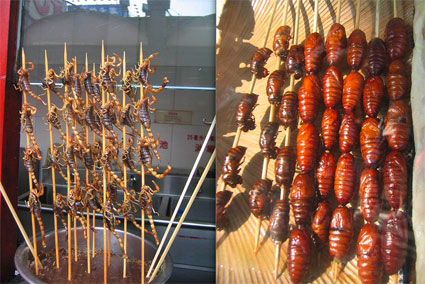 Yummy healthy insecty snack seen in the streets of Beijing
Yummy healthy insecty snack seen in the streets of Beijing
Mind you, researchers have devised new but rather unappealing ways to have us enjoy food like never before: fish are being trained to catch themselves, we’ll be able to choose between meat from cloned animals and in vitro meat and encouraged to get better proteins by snacking on insects.
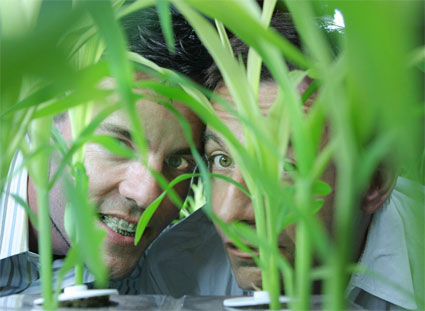
Matias Viegener and David Burns have added the corn issue on the table.
You might know them for their ongoing collaboration with Austin Young: Fallen Fruit, a project which encourage people not only to map “public fruit”, fruit which grew on private trees and fell on public spaces, but also to harvest and plant fruit parks in under-utilized areas.
Back in 2004, Matias and David worked on an installation which i discovered only recently. That year, Fritz Haeg (of the Edible Estates fame) and Francois Perrin produced and curated the GardenLAb experiment. Set in a 1942 supersonic wind tunnel, the event explored the relationship Los Angeles residents have with their environment by experimenting and speculating on current and future ecologies.
 The “Coop Wind Tunnel”
The “Coop Wind Tunnel”
Corn Study humourously addresses the future of human food production and the ongoing consequences of issues that range from the latest developments in genetic manipulation, mistreatment of plants and animal species, corporate control and profit motivation, diminishing genetic diversity, modification of our ecosystem, privatization of ownership of plant’s genome, etc.
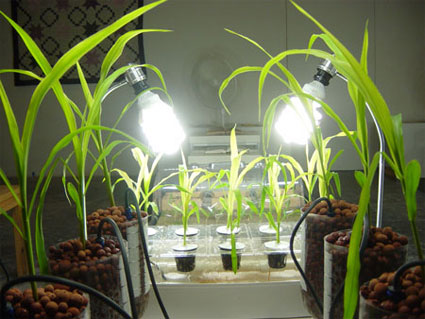 Corn Study, detail (Figure 0038), 2004. Photography Austin Young
Corn Study, detail (Figure 0038), 2004. Photography Austin Young
One of Corn Study’s objectives was to develop a new relationship with the corn species.
While great effort has been put into the human understanding of plants, very little has been expended to educate the corn and teaching it about the humans that control its fate. The project creates a school for corn with an experimental curriculum to educate the corn in human psychology and sociology, the economics of commerce, important languages, current events and the history of colonialism.
Through the use of audio and autosuggestion the artists deployed Aldous Huxley‘s theories of hypnopedia: the most powerful educational device being unconscious suggestion to the embryo to maximize its developmental potential.
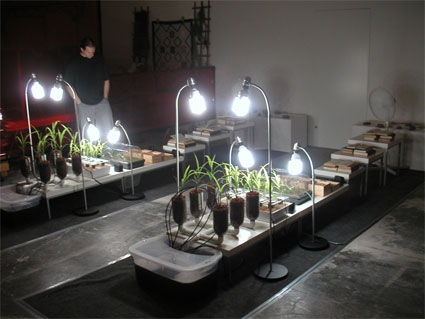
The school is set up on ten tabletops with different learning stations, with the corn seeds learning through audio speakers as well as by the use of electric fans behind a row of books, which carry knowledge through the air like pollen. In this program of accelerated learning, the individual kernel is not expected to learn everything — the species as a whole will absorb the knowledge collectively. The variety of knowledge bases is hoped to heighten the corn’s wisdom, especially since despite their enormous acquisition of knowledge, humans have acquired so little wisdom.
As the artists conclude in their presentation of the project: While it may take many generations before the outcome of our experiment can be demonstrated, we are hoping for positive mutations and raised consciousness in the corn, to be passed along to other species. At this stage of global development, humans can no longer be entrusted with full stewardship of the environment. Perhaps if other species can intervene, they will do a better job.
I asked Matias and David to tell me more about the school for corn species:
We’ve been hearing and reading about genetic manipulation for years now. I sometimes think that consumers got used to it, accepted the idea and wouldn’t mind buying and eating GMO (or even cloned meat when it lands in our supermarket fridges.)
What exactly should we be worried about? What is different in the new forms of manipulations Corn Study comments on?
While we were interested in genetic manipulation we wanted to work away from it. The basis of Corn Study was the idea that corn had been studied and manipulated more than any other plant than perhaps soybeans. While we’re disinclined to GM foods, it seems clear that all our agricultural foods have been manipulated for millennia. So we wanted to refocus the question of GM foods into the broader question of how humans have studied and changed our foods without any seeming consideration for the nature (or the education) of the foods themselves. What if we could give the corn some agency of its own, educating it about its human hosts. Our ironic goal was to find a way for the corn to gain some power over its own fate, to “speak out” if it could, by learning more about us and both the good and the bad of the human universe.
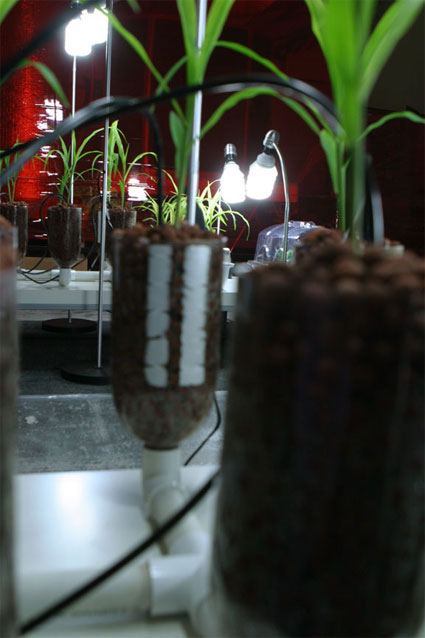 What does corn education involves exactly? Could you guide us through the whole curriculum?
What does corn education involves exactly? Could you guide us through the whole curriculum?
While there was a lot of specific material, there was no defined curriculum for the corn school. Or maybe a better way to say this is that we could have endlessly kept adding educational material to the school. Here’s a quote from the original text that was distributed to visitors:
“The curriculum is composed of texts, lectures and readings in political science, history, psychology, philosophy, foreign languages and cultural studies; we have tried to select materials that help outline the background of our global socioeconomic, political and environmental circumstances. For the student’s personal growth we include tapes on self-actualization, meditation, hypno-suggestion, and personal dynamics. The songs are mostly pop music from the 60’s and 70’s, chosen to reflect the optimism of a time now fallen by the wayside. Included in our coursework are Noam Chomsky, Friedrich Nietzsche, Marxist theory, Mahatma Ghandi, Winston Churchill, Neil Armstrong, Machiavelli, Plato, Immanuel Kant, Abraham Lincoln, Anthony Robbins, Brian Tracy, Zig Ziglar, Lao Tzu, Gloria Steinem, Elizabeth Vandiver, greek myths, Howard Zinn, Ken Wilber, Malcolm x, Michael Moore, Ralph Nader, Lyndon B. Johnson, Al Sharpton, Terence McKenna, Aldous Huxley, Paul Scheele, Michael Pollan, Henry Thoreau, various international Pimsleur language audiobooks, The New Christie Minstrels, Melanie, Paul Williams, Ray Charles, The Carpenters, Cher, Three Dog Night, The 5th Dimension, Donovan, Bread, Dolly Parton, Jefferson Airplane, Sly and the Family Stone, the Doors, and John Denver.”
Do you welcome both “natural” and modified corns in your classes? Is there any segregation?
We welcomed all corn to the school, including GM corn. We tried for a good mix of modern hybrids and ancient or “heirloom” corn varieties. We don’t think one group is in any way superior to the others. The idea was to empower the species as a whole to make collective decisions and perhaps take actions to both improve their lot in the world and deflect any more human mismanagement of it. Halfway through the design we realized that all seeds of all species should be welcomed to the school, without distinction between crops and weeds, the good or the bad, which are all values that come from humans and not from nature itself.
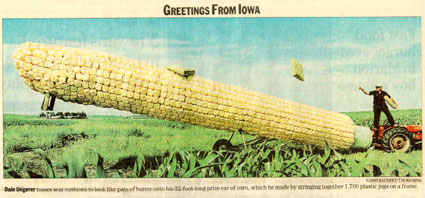 Giant Iowa corn
Giant Iowa corn
Why did you choose to work with corn? Wouldn’t animals seem like a more natural and rewarding choice?
We worked with corn because of the place it holds in American culture. Americans consume more corn products than any other nationality (and in recent years corn has been blamed for a host of our health problems.) We love animals but this sort of project was hard enough to mount with the immobile corn plants… it’s hard to think how we would have done it with a herd of cattle.
I read that plants communicate. Do you expect your corn students to spread their newly acquired knowledge to their companions?
It’s certainly possible for plants to communicate, and perhaps we succeeded in communicating with them, and that our ideas got passed along the botanical spectrum. Of course the real audience for Corn Study was human. We felt that in addressing the corn, the humans might consider seeing the universe from a less human-centric position. Just as we have no preconception about how these ideas would flow through to the plants, we were very open to how they might arrive to the human spectator. A key to our work here is the use of play combined with what we think of as vital issues of our times. Much of our work plays on corniness as a way to be serious, on the relation between pure, purposeful aesthetic or cultural ideas and the low, foolhardy kitsch of the ordinary world. We’re not interested in art that’s pedantic, but we do care about conveying ideas and questioning values. We’re not especially interested in art that creates objects either, but we are invested in the way in which artmaking expands the variety of containers for ideas (and can make things in general look nicer).
Thanks Matias and David!
All images are from the installation at GardenLAb.
Related: Nigel Helyer´s Host, in which an audience of several crickets attend a lecture concerning the sex life of insects and Aron’s School for Frogs.
